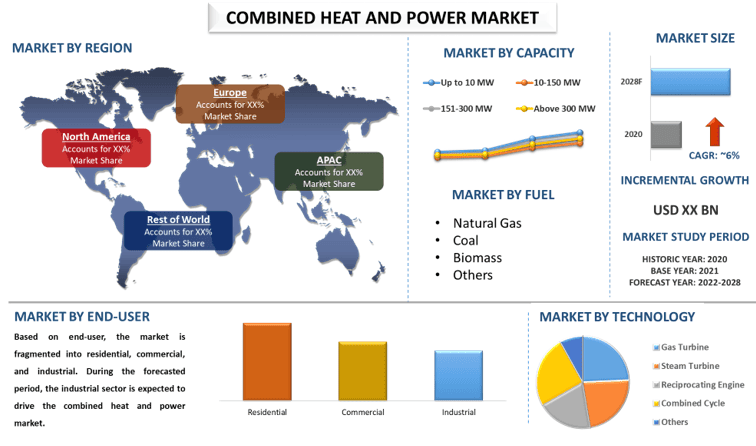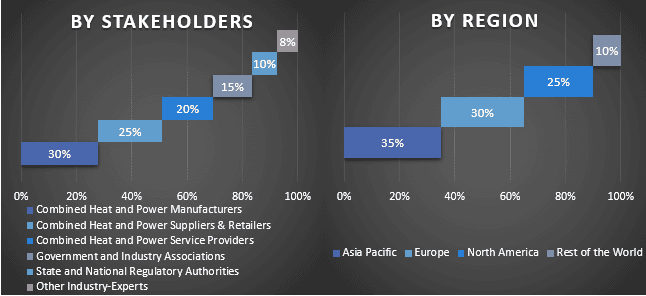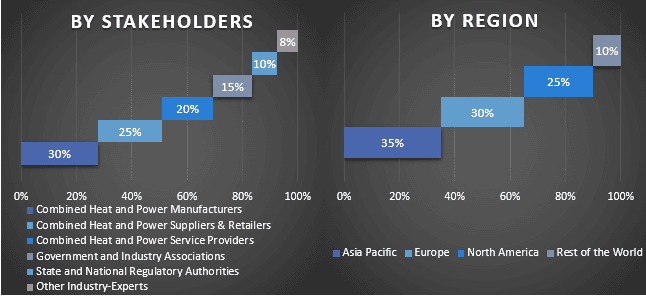Emphasis on Capacity (Up to 10 MW, 10-150 MW, 151-300 MW, above 300 MW); Fuel (Natural Gas, Coal, Biomass, Others); Technology (Gas Turbine, Steam Turbine, Reciprocating Engine, Combined Cycle, Others); End-User (Residential, Commercial, and Industrial); and Region/Country

The global Combined Heat and Power market is expected to witness a CAGR of around 6% during the forecast period (2022–2028). As the market is anticipated to witness an uptick in growth owing to the dependent and independent variables as a single source of energy is seen. For instance, China’s Tianjin Junliangcheng Power Generation built a gas-fired cogeneration power plant to replace a coal-fired power plant.
In addition, major players such as Bosch Thermotechnology Limited, General Electric Co., ABB Ltd., Siemens AG, Cummins, Mitsubishi Heavy Industries, Man Energy Solutions, Caterpillar Inc, Wartsila Corp., and Veolia. Several M&As along with partnerships have been undertaken by these players to develop the combined heat and power market.
Combined Heat and Power is also known as cogeneration. It is defined as the concurrent production of electricity or mechanical power and useful thermal energy from a single source of energy. In addition, the system recovers lost energy by using the combined heat, which is otherwise wasted, to power plants or buildings that are connected to the energy plant through a stream pipe network. This wasted combined heat is applied to facility loads in the process of combined heating, steam, hot water, or chilled water.
However, Covid – 19 has devasted the global economy due to which many sectors experienced a downfall as the supply of power got reduced. In addition, the consumption of electricity, production of the value chain, food processing units, and any others impacted the combined heat and power market as the production of power got severely less. Furthermore, many industries such as energy, and chemicals had cut operating expenses and capital expenditures due to the uncertain economic drop. As the industries are in progress from a certain period the production and growth of the combined heat and power market are on a growth path, and it is expected to grow during the forecasted period.
Insights Presented in the Report
“Amongst capacity, up to 10 MW category to hold a significant share in the market”
Based on capacity, the market is fragmented into up to 10 MW, 10-150 MW, 151-300 MW, and above 300 MW. During the forecast period, up to 10 MW segment is likely to held significant share in the combined heat and power market owing to the demand mainly coming from personal, industrial, and commercial end-users. Since the residential combined heat and power market systems range from just 1.5kW to 0.5MW and typically require natural gas to operate which is leading the market growth of up to 10 MW combined heat and power systems. Therefore, it helps reduce energy costs compared to other conventional systems. In addition, Up to 10 MW is driven by the government’s micro-CHP program for fuel cells. Unlike reciprocating engines and gas turbines, fuel cells generate electricity without burning fuel. For instance, AB Holding, 2G Energy, FuelCell Energy and Capstone typically offer cogeneration solutions in this power range.
“Amongst fuel, natural gas to hold a significant share in the market”
Based on fuel, the market is fragmented as natural gas, coal, biomass, and others. During the forecasted period, the natural gas industry is expected to drive the combined heat and power market. As the price of natural gas is expected to gain competence compared to other fuels on account of its high efficiency, increased production across the globe, and significantly low carbon emissions. Globally, governments are attempting to increase the percentage of cleaner fuels in their energy mix, which will eventually bring up demand for natural gas in the coming years. Additionally, the growing demand will lead regulators to enhance the production of natural gas, which in turn, will proliferate the market expansion globally which will drive the growth of the market.
Amongst technology, combined cycle industry to hold a significant share in the market”
Based on technology, the market is fragmented as gas turbines, steam turbines, reciprocating engines, combined cycles, and others. During the forecasted period, the combined cycle industry is expected to drive the combined heat and power market. It is utilized in power plants to lessen energy losses as waste heat built up in exhaust gases is employed to generate additional electricity. These systems are employed mostly in industrial sectors including petrochemicals, chemicals, cement, paper, pulp, sugar, and pharmaceuticals where there is a strong need for energy. The key factors considered are the ability to operate without fuel, the cheap installation and maintenance costs, the thermal output, the start-up time, the availability of fuel, the level of emission, and how energy-efficient the technology is in comparison to others.
“Amongst end-user, industrial is accounted for a significant market share in 2020”
Based on end-user, the market is fragmented into residential, commercial, and industrial. During the forecasted period, the industrial sector is expected to drive the combined heat and power market. With the increasing installations of combined heat and power systems in different applications including, petrochemical and pharmaceutical industries. In addition, encouragement of directives to surge combined heat and power installation across solar power units and expand the residential and commercial sector supported by industrialization benefit the industrial segment. Furthermore, the combined heat and power units are mainly used in industries due to the increasing need for power.
APAC to witness significant growth during the forecast period”
The Asia-Pacific region is expected to have a major share in the combined heat and power industry. This is mainly due to the rapid industrialization and urbanization as well as the increasing market demand for clean fuel energy boosted the market’s growth in the region leading to the growth of new combined heat and power systems in the emerging economies. For instance, in November 2020, Bert Energy GmbH unveiled a Bert Mobil Gas demo scheduled for commissioning in Sri City, Andhra Pradesh, India. In addition, the natural gas supply and price outlook, increased energy efficiency, and environmental regulations for power plants and industrial boilers are expected to positively drive cogeneration installations across the region. However, factors such as weak grid connectivity and high capital expenditures remain major challenges for the cogeneration market in the Asia-Pacific region.
Reasons to buy this report:
Customization Options:
The Global Combined Heat and Power Market can further be customized as per the requirement or any other market segment. Besides this, UMI understands that you may have your own business needs, hence feel free to connect with us to get a report that completely suits your requirements.
1. Market Introduction
2. Research Methodology Or Assumption
3. Market Synopsis
4. Executive Summary
5. Global Waste Heat Recovery System Market Covid-19 Impact
6. Global Waste Heat Recovery System Market Revenue (usd Bn), 2020-2027f
7. Market Insights By Capacity
8. Market Insights By Fuel
9. Market Insights By Technology
10. Market Insights By End-user
11. Market Insights By Region
12. Waste Heat Recovery System Market Dynamics
13. Waste Heat Recovery System Market Opportunities
14. Waste Heat Recovery System Market Trends
15. Value Chain Analysis
16. Competitive Scenario
17. Company Profiled
18. Disclaimer
Research Methodology for the Global Combined Heat and Power Market Analysis (2022-2028)
Analyzing the historical market, estimating the current market, and forecasting the future market of the global combined heat and power market were the three major steps undertaken to create and analyze the adoption of combined heat and power in major regions globally. Exhaustive secondary research was conducted to collect the historical market numbers and estimate the current market size. Secondly, to validate these insights, numerous findings and assumptions were taken into consideration. Moreover, exhaustive primary interviews were also conducted, with industry experts across the value chain of the global combined heat and power market. Post assumption and validation of market numbers through primary interviews, we employed a top-down/bottom-up approach to forecasting the complete market size. Thereafter, market breakdown and data triangulation methods were adopted to estimate and analyze the market size of segments and sub-segments of the industry pertains to. Detailed methodology is explained below:
Analysis of Historical Market Size
Step 1: In-Depth Study of Secondary Sources:
Detail secondary study was conducted to obtain the historical market size of the combined heat and power market through company internal sources such as annual reports & financial statements, performance presentations, press releases, etc., and external sources including journals, news & articles, government publications, competitor publications, sector reports, thirsd-party database, and other credible publications.
Step 2: Market Segmentation:
After obtaining the historical market size of the combined heat and power market, we conducted a detailed secondary analysis to gather historical market insights and share for different segments & sub-segments for major regions. Major segments included in the report as capacity, fuel, technology, and end-user. Further country-level analyses were conducted to evaluate the overall adoption of testing models in that region.
Step 3: Factor Analysis:
After acquiring the historical market size of different segments and sub-segments, we conducted a detailed factor analysis to estimate the current market size of the combined heat and power market. Further, we conducted factor analysis using dependent and independent variables such as various capacities, fuel, technology, and end-user of combined heat and power equipment. A thorough analysis was conducted for demand and supply-side scenarios considering top partnerships, mergers and acquisitions, business expansion, and product launches in the combined heat and power market sector across the globe.
Current Market Size Estimate & Forecast
Current Market Sizing: Based on actionable insights from the above 3 steps, we arrived at the current market size, key players in the global combined heat and Power market, and market shares of the segments. All the required percentage shares split, and market breakdowns were determined using the above-mentioned secondary approach and were verified through primary interviews.
Estimation & Forecasting: For market estimation and forecast, weights were assigned to different factors including drivers & trends, restraints, and opportunities available for the stakeholders. After analyzing these factors, relevant forecasting techniques i.e., top-down/bottom-up approach were applied to arrive at the market forecast for 2027 for different segments and sub-segments across the major markets globally. The research methodology adopted to estimate the market size encompasses:
Market Size and Share Validation
Primary Research: In-depth interviews were conducted with the Key Opinion Leaders (KOLs) including Top Level Executives (CXO/VPs, Sales Head, Marketing Head, Operational Head, Regional Head, Country Head, etc.) across major regions. Primary research findings were then summarized, and statistical analysis was performed to prove the stated hypothesis. Inputs from primary research were consolidated with secondary findings, hence turning information into actionable insights.
Split of Primary Participants in Different Regions

Market Engineering
The data triangulation technique was employed to complete the overall market estimation and to arrive at a precise statistical number for each segment and sub-segment of the global combined heat and power market. Data was split into several segments & sub-segments post studying various parameters and trends in the areas of various power/capacity, applications, and end-user in the global combined heat and power market.
The main objective of the global Combined Heat and Power Market Study
The current & future market trends other than the global combined heat and power market were pinpointed in the study. Investors can gain strategic insights to base their discretion for investment on the qualitative and quantitative analysis performed in the study. Current and future market trends determined the overall attractiveness of the market at a regional level, providing a platform for the industrial participant to exploit the untapped market to benefit from a first-mover advantage. Other quantitative goals of the studies include:
Deep dive regional level analysis of the industry

Customers who bought this item also bought